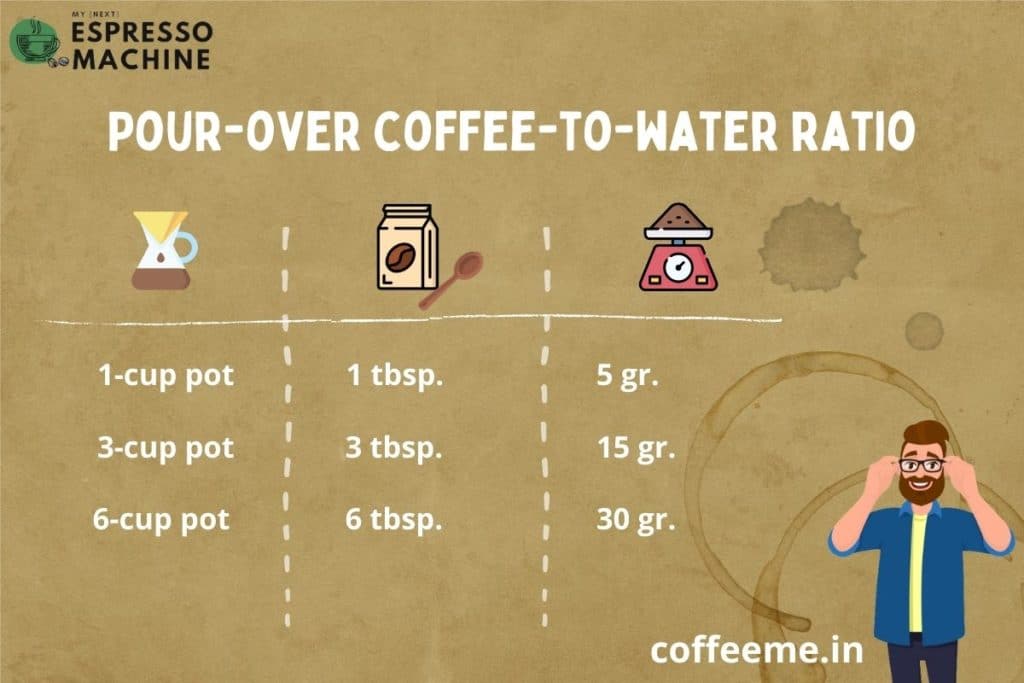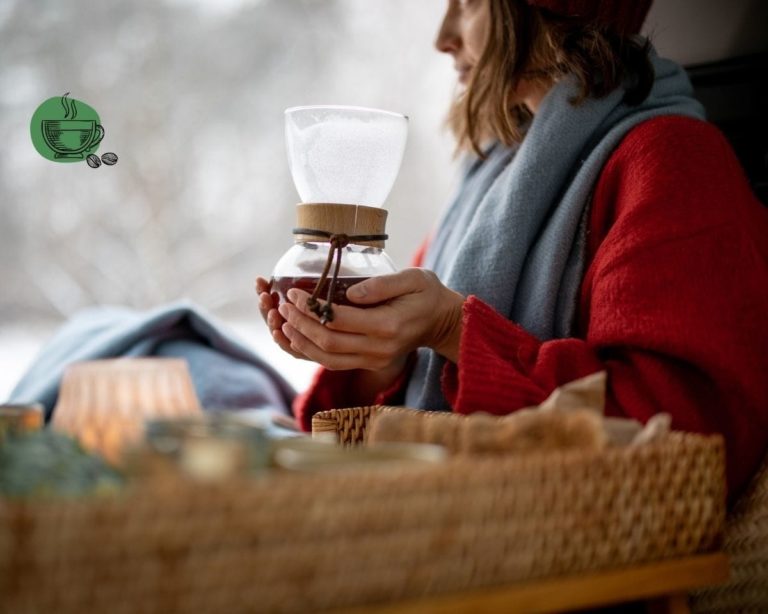If you’re looking for the right coffee-to-water ratio when using a Pour Over coffee maker, go with one tablespoon of coffee for every cup of water. But There’s a lot more to learn if you want to make the best pour-over coffee the right way.
A pour-over coffee maker is a coffee brewing method that uses a cone-shaped paper filter to separate ground coffee from water. The filter sits over a glass, ceramic cup, pot, or carafe.
With your pour-over coffee maker, I encourage you to try different types of ground coffee, such as decaf, single-origin, or flavored beans.
Skip to the best part:
What makes Pour-Over Coffee So Popular?
The popularity of pour-over coffee has risen dramatically over the past few years. You can see pour-over coffee makers nowadays just about anywhere, from homes to cafés, to hotel rooms.
The pour-over trend is growing as an alternative to more traditional espresso-based coffees. This coffee-making technique might seem to some as a more “sophisticated” and “artisanal” way of preparing coffee, compared with coffee-brewing methods requiring automated espresso machines or coffee makers.
How to Choose the Right Roast and Grind for Your Pour-Over Coffee
Good pour-over coffee requires a medium-coarse grind, but it’s a matter of personal taste.
A more coarse grind will cause the water to pass through the filter too quickly, producing a weaker, less bitter coffee. A fine coffee grind will make the water drip through the filter slowly, making the coffee extra strong and bitter.
Choosing the proper roast is also crucial. Pour-over coffee is typically brewed with boiling water (I wouldn’t recommend it), hotter water than other brewing methods, which extracts more flavor from the beans.
I suggest you use trial and error to find the perfect roast for your taste. You can start with a medium-dark roast and decide if you should go with a lighter or darker roast in your next experiment.
Pour-over coffee to water ratio
When it comes to making a pour-over coffee, the ratio of coffee to water is an essential factor. You don’t want your coffee to be too weak or, on the other hand, too strong and bitter.
If you’re used to other coffee brewing methods, please note that the coffee to water ratio of a pour-over differs from that in a French Press or a Moka Pot.
A great starting point would use the standard ratio of 1:16. It means that for every 16 ounces of water (two cups), you need about one ounce of coffee beans (two tablespoons). The easy way to put it is to use one tablespoon of coffee for every cup of water.
Your choice of coffee beans also affects the amount of coffee you should use. For example, if you use a coarse grind with a light roast and feel your coffee taste weak or sour, add some more coffee when brewing.
As always – practice makes perfect. Find what works best for your own taste buds.

Check out these pour-over coffee makers models on Amazon:
How to Make Pour-Over Coffee
Step 1: Get your equipment and ingredients ready
This part is easy. Make sure you have water, a kettle, coffee beans for pour-over coffee to your liking (see above), a paper filter, and of course: a pour-over coffee maker.
Step 2: Measure the Right Amount of Medium Coarse Ground Beans
As mentioned earlier, a medium-coarse grind of medium-dark roast beans should be your starting point. Feel free to experiment and find the just-right grind and roast level to match your personal taste.
Make sure you know how many cups your pot contains, and use about one tablespoon of ground coffee for every cup of water.
Step 3: Rinsing the filter while preheating the pot or carafe.
Boil the water and place the filter above the pot or carafe. Pour some boiling water over the filter to rinse it. It will help eliminate any paper-ish taste while preheating the pot. When you're done - dispose of the water. Now you're ready to brew your coffee.
Step 4: Blooming your coffee
Ensure everything's in place: The filtering device with the rinsed paper filter over your carafe or empty mug. The water shouldn't be 100% boiling, so wait a moment after the water boils before pouring the water over.
Put the ground coffee at the bottom of the filter and pour just a bit of water over it just to get it wet.
You might notice some foam gathering above the coffee grounds. This process is called "Blooming," which ensures better flavor and oils extractions by letting the freshly ground coffee open and release some gases.
Let the coffee bloom for about 30-60 seconds.
Step 5: Brewing (finally!)
Carefully pour the hot (not boiling) water over the coffee grounds and wait for the water to drip completely. Dispose of the filter, and you're done!

The cleaning process
Cleaning a pour-over coffee maker is easy. So there's no excuse not to clean the coffee maker after each use to avoid any buildup of oils and residue that can affect the taste of the next cup.
Start by removing any leftover coffee from the filter and discarding it in the trash (with the paper filter). Then rinse out all of the parts with water.
When everything appears clean, use a small amount of mild detergent and a soft brush to scrub everything gently. Make sure to get all of those hard-to-reach spots. That includes the inside of the carafe spout and around where water drips out of your filter holder.
Make sure to rinse your pour-over coffee well to avoid any soapy taste on subsequent uses, and let it dry well before storing.
Pour-Over Coffee - Conclusion
A Pour-Over Coffee is a great quick way to start your day with a caffeine boost. Some say it is more "sophisticated" and "artisanal" than other coffee brewing methods.
If you're confused about choosing the roast and grind level, go with a medium-dark roast and a medium-coarse grind level as a starting point. Feel free to change the roast and grind level a bit next time you're having coffee until you find the perfect combination of coffee roast and grind level for your liking.
The coffee to water ratio is about one tablespoon of ground coffee to one cup of water.
When making yourself pour-over coffee, make sure you rinse the filter and preheat the pot. Let the coffee grounds bloom and open a little before pouring very hot (but not boiling) water.
Check out these pour-over coffee makers models on Amazon:
Pour-Over Coffee Maker FAQs
What is the coffee to water ratio for pour over coffee?
Start with one tablespoon of coffee for every cup of water.

How to Make Pour-Over Coffee
Step 1: Get your equipment and ingredients ready
This part is easy. Make sure you have water, a kettle, coffee beans for pour-over coffee to your liking (see above), a paper filter, and of course: a pour-over coffee maker.
Step 2: Measure the Right Amount of Medium Coarse Ground Beans
As mentioned earlier, a medium-coarse grind of medium-dark roast beans should be your starting point. Feel free to experiment and find the just-right grind and roast level to match your personal taste.
Make sure you know how many cups your pot contains, and use about one tablespoon of ground coffee for every cup of water.
Step 3: Rinsing the filter while preheating the pot or carafe.
Boil the water and place the filter above the pot or carafe. Pour some boiling water over the filter to rinse it. It will help eliminate any paper-ish taste while preheating the pot. When you’re done – dispose of the water. Now you’re ready to brew your coffee.
Step 4: Blooming your coffee
Ensure everything’s in place: The filtering device with the rinsed paper filter over your carafe or empty mug. The water shouldn’t be 100% boiling, so wait a moment after the water boils before pouring the water over.
Put the ground coffee at the bottom of the filter and pour some water over it, just to get it wet.
You might notice some foam gathering above the coffee grounds. This process is what we call “Blooming”, which ensures better flavor and oils extractions by letting the freshly ground coffee open and release some gases.
Let the coffee bloom for about 30-60 seconds.
Step 5: Brewing (finally!)
Carefully pour the hot (not boiling) water over the coffee grounds and wait for the water to completely drip. Dispose of the filter, and… you’re done!

What is the best kind of coffee for pour over coffee makers?
Good pour-over coffee requires a medium-coarse grind, but it’s a matter of personal taste.
A more coarse grind will cause the water to pass through the filter too quickly, producing a weaker, less bitter coffee. A fine coffee grind will make the water drip through the filter slowly, making the coffee extra strong and bitter.
How to clean a pour over coffee maker?
Cleaning a pour-over coffee maker is easy. So there’s no excuse not to clean the coffee maker after each use to avoid any buildup of oils and residue that can affect the taste of the next cup.
Start by removing any leftover coffee from the filter and discarding it in the trash (with the paper filter). Then rinse out all of the parts with water.
When everything appears to be clean, use a small amount of mild detergent and a soft brush to scrub everything gently. Make sure to get all of those hard-to-reach spots. That includes the inside the carafe spout and around where water drips out of your filter holder.
Make sure to rinse your pour-over coffee well to avoid any soapy taste on subsequent uses, and let it dry well before storing.



